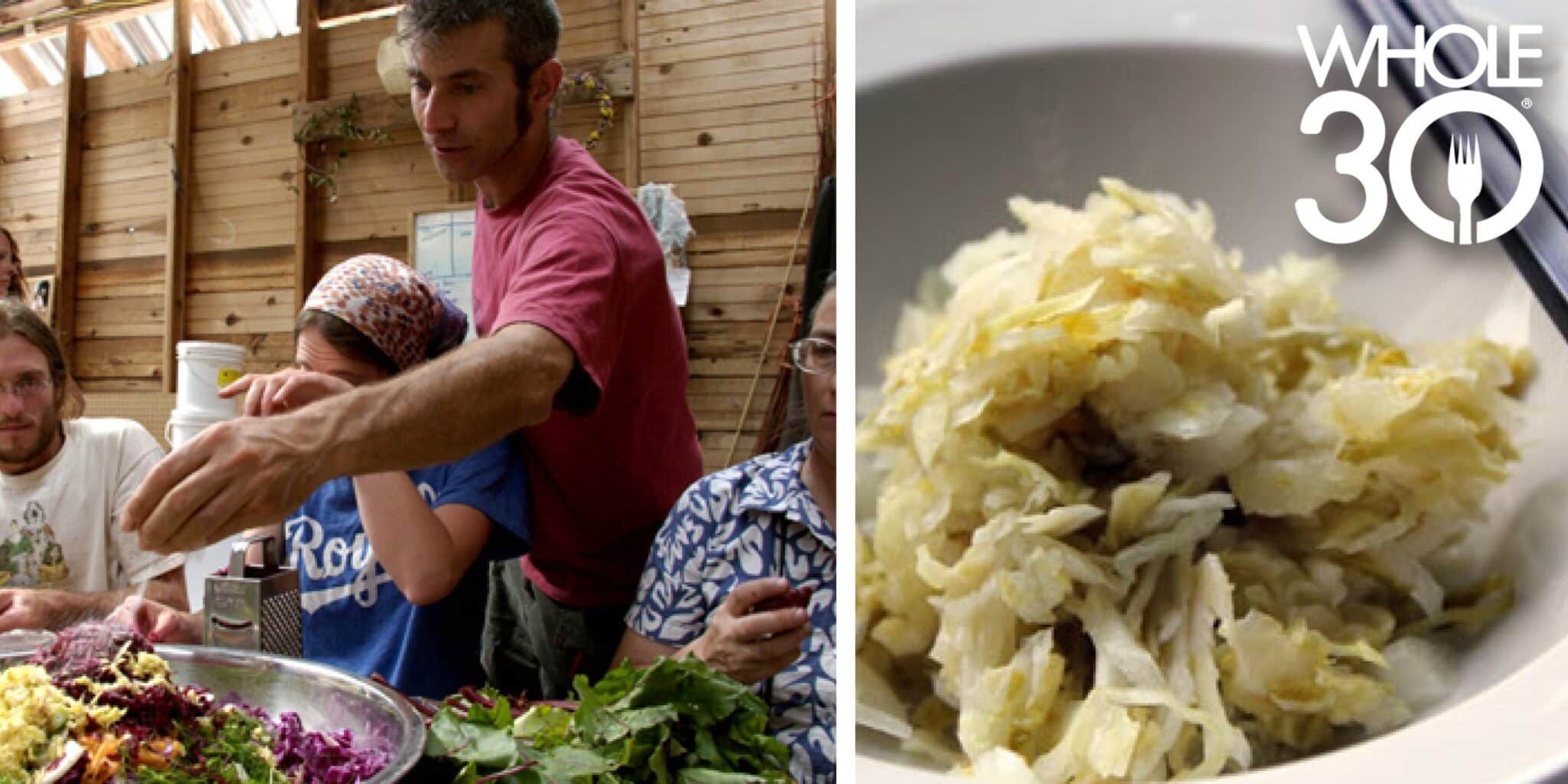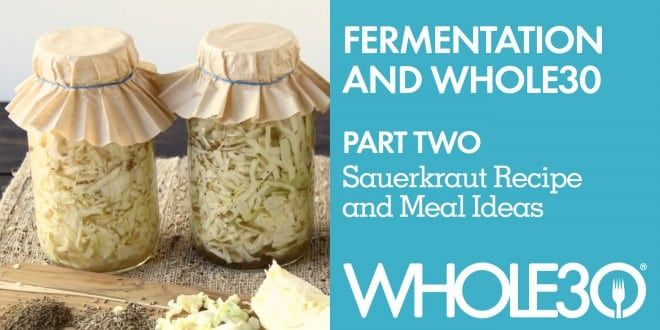Today we’re sharing part two of our Fermentation 101 series with Sandor Katz, fermentation expert and New York Times bestselling author of The Art of Fermentation. Don’t miss part one, where Sandor answers questions about fermentation, straight from the Whole30 community. If you’re ready to experiment with fermenting your own foods at home, here is Sandor’s step-by-step method for making sauerkraut. Once you’ve mastered this process, you can develop your own signature sauerkraut by experimenting with different veggies and flavors.
Sandor’s Sauerkraut Recipe

Equipment 1 quart/1 liter wide-mouth jar, or a larger jar or crock
Ingredients
2 pounds (1 kg) of vegetables per quart/liter. This can include any variety of cabbage, either a single variety or a combination, or at least 1/2 cabbage and the remainder any combination of radishes, turnips, carrots, beets, kohlrabi, Jerusalem artichokes, onions, shallots, leeks, garlic, greens, peppers, or other vegetables. Approximately 1 tablespoon salt (start with a little less) Other seasonings as desired, such as caraway seeds, juniper berries, dill, chili peppers, ginger, turmeric, dried cranberries, or whatever you can conjure in your imagination
Process
REMOVE outer leaves of the cabbage and reserve. If you’re using any root vegetables, scrub them but do not peel. Chop or grate vegetables into a bowl. The purpose of this is to expose surface area in order to pull water out of the vegetables, so the vegetables can be submerged under their own juices. The finer the veggies are shredded, the easier it is to get juices out, but fineness or coarseness can vary and you will still have satisfactory results.
SALT vegetables lightly and add seasonings as you chop. Sauerkraut does not require heavy salting. After completing the next step, taste the mixture and add more salt or seasonings if desired. It is always easier to add salt than to remove it.
SQUEEZE salted vegetables with your hands for a few minutes (or pound with a blunt tool). This bruises the vegetables, breaking down cell walls and enabling them to release their juices. Squeeze until you can pick up a handful and when you squeeze, juice releases (as from a wet sponge).
PACK salted and squeezed vegetables into your jar. Press vegetables down with force, using your fingers or a blunt tool, so that air pockets are expelled and juice rises up and over the vegetables. Fill jar almost all the way to the top, leaving a little space for expansion. The vegetables have a tendency to float to the top of the brine, so it’s best to keep them pressed down, using one of the cabbage’s outer leaves, folded to fit inside the jar, or a carved chunk of a root vegetable, or a small glass or ceramic insert. Screw the top on the jar; lactic acid bacteria are anaerobic and do not need oxygen (though they can function in the presence of oxygen). However, be aware that fermentation produces carbon dioxide, so pressure will build up in the jar and needs to be released daily, especially the first few days when fermentation will be most vigorous.
WAIT. Be sure to loosen top to relieve pressure each day for the first few days. The rate of fermentation will be faster in a warm environment, slower in a cool one. Some people prefer their krauts lightly fermented for just a few days; others prefer a stronger, more acidic flavor that develops over a longer time. Taste after just a few days, then a few days later, and at regular intervals to discover what you prefer. Move to refrigerator if you wish to stop (or rather slow) fermentation. In a cool environment, kraut can continue fermenting slowly for months. In the summer or in a heated room, its life cycle is more rapid; eventually it can become soft and mushy. The most common problem that people encounter in fermenting vegetables is surface growth of yeasts and/or molds, facilitated by oxygen. Many books refer to this as “scum,” but I prefer to think of it as a bloom. It’s a surface phenomenon, a result of contact with the air. If you should encounter surface growth, remove as much of it as you can, along with any discolored or soft kraut from the top layer, and discard. The fermented vegetables beneath will look, smell, and taste fine. The surface growths can break up as you remove it, making it impossible to remove all of it. Don’t worry about this, it’s benign.
ENJOY your kraut! I start eating it when the kraut is young and enjoy its evolving flavor over the course of a few weeks (or months in a large batch). Be sure to try the sauerkraut juice that will be left after the kraut is eaten. Sauerkraut juice packs a strong flavor, and is unparalleled as a digestive tonic.
DEVELOP a rhythm. Start a new batch before the previous one runs out. Get a few different flavors or styles going at once for variety. Experiment!
Variations In addition to experimenting with the types of vegetables and seasonings you use in your sauerkraut, Sandor also recommends experimenting with the following methods:
- Add a little fresh vegetable juice or “pot likker” (the liquid that’s leftover after you’ve boiled greens) and dispense with the need to squeeze or pound
- Incorporate mung bean sprouts or hydrated seaweed
- Add shredded or quartered Brussels sprouts
- Add cooked potatoes (mashed, fried, and beyond, but be certain they’re cool before you add them to your mixture)
- Add dried or fresh fruit
- Once you become comfortable with the fermentation process, the possibilities are infinite
Our Favorite Ways to Use Fermented Ingredients
You can always eat your sauerkraut straight out of the jar while you decide what to make for dinner (this is how most members of the Whole30 team incorporate fermented foods into their diets). But if you’re looking for specific ideas on how to incorporate fermented foods into your Whole30 meals, here are some ideas:
- Add kimchi to your next frittata or morning scramble.
- Sauerkraut is a fantastic topping for your next burger.
- Use fermented vegetables as a condiment for your favorite “lettuce wrap” recipe.
- Split your Whole30 compatible hot dog or sausage down the middle, and stuff it with sauerkraut or a dill pickle spear.
- Use sauerkraut, kimchi or pickled veggies as a flavorful element in a big salad.
- Sauerkraut pairs especially well with pork; try it as a side dish next time you serve pork chops or a pork roast.
- Pickled vegetables are excellent in any kind of protien salad: chicken, tuna or salmon.
- Add fermented foods to your next Whole30 “ingredient meal“
- Add sauerkraut or kimchi to the line-up of topping options next time you serve a Whole30 compatible chili bar.
For more information on adding fermented foods to your diet, check out the Whole30 Forum. Have a delicious Whole30 dish that calls for fermented foods? Connect with us on Instagram, Facebook and Twitter to share it!

















